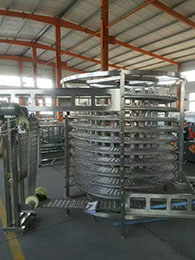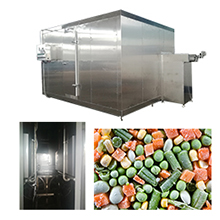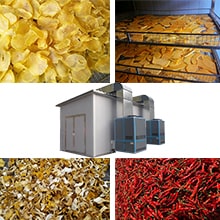Dehydration and freezing unit operation in foodstuffs preservation
Dehydration and freezing unit operation in foodstuffs preservation
Frying dehydration, Drying dehydration and Food Freezing retard spoilage to extend food shelf life by means of destroy or inhibiting microorganisms activity in practical food process unit operation.
Send Query Download PDFFoodstuffs, fresh vegetables and fruits always face the spoilage. How to preserve the overall quality of the food over a certain duration known as shelf life is one of food processing objective.
Spoilage source mainly comes from the microorganisms activity, enzyme and non-enzymatic chemical reactions in foods.
In comparison, the major deterioration is microbial spoilage which affect both the quality and the safety of food.
Fruits, vegetables, raw meat, fish and other foodstuffs has the high moisture. On the bright side, as a constituent ,water is essential for the good texture and appearance of fruits and vegetables. To the contrary, water, also being a support of chemical reactions and microbial growth, is often responsible for the microbial, enzymatic and chemical deterioration of food.
Therefore, retard spoilages to extent food shelf life by means of destroy or inhibiting microorganisms activity is the common ways in practical food process unit operation.
| Destroy microorganisms | Frying dehydration |
| Reduction of water activity | Drying dehydration |
| Freezing |
Deep fat Frying and Vacuum frying
Frying is a process in which food is cooked being immersed in hot edible oil or fat, also known as deep fat frying and, in essence, is a fast dehydration process. In addition, the frying oil also becomes a component of the end product, developing unique sensory aspects in palatability.
Frying provides a preservative effect that results from thermal destruction of microorganisms and enzymes, and a reduction in water activity by means of removal moisture from the raw food for shelf stable items like snacks to 1.5 to 2%.
Deep fat frying is an important unit operation in the manufacture of many snack foods, frozen French fries and for the preservation and cooking of many other foods.
Deep fat fried foods have a shelf life up to several months. Storage stability of these products may be increased by using packaging materials with adequate barrier properties.
The exceptions are, some par-fried foods, like prepared French fries, still retain a high moist interior. These special foodstuffs should be stored under freezing conditions to expect a longer time.
A limitation of deep fat frying foods is the high fat content, which is considered a risk factor for health. Likewise, it has been pointed out that thermo labile vitamins such as C (ascorbic acid) and those of group B (thiamine, riboflavin, niacin, pantothenic acid, pyridoxine, biotin, folic acid and cobalamin), decrease in fried foods (Omidiran et al. 2016).
Hence, alternatively, vacuum frying technology maybe a idea frying unit operation. It lowers the frying temperature, reduces the amount of oil the food absorbs and retain more nutrients when compared to traditional frying methods.
Batch operation Deep fat fryer

Oil (Fat)-water mixture frying technology
Fried food residues are deposited into water throughout a mesh filter. Thus,
Frying oil pollution will be much reducer to result as long service lives and more clean.
Frying fat consumption is unexpected less as the fat in residues will be return to the frying oil before discharge.
Optional
Manual operation for small scale deep fat fryer
Automatic loading, discharging with or without stirring deep fat fryer
Electric heating or gas fire heating
Continuous deep fat fryer

A standard continuous deep fat frying fryer includes:
1. an frying tank where the food is submerged in hot oil for frying process, equipped moving mesh belt conveyors and insulation shell ;
2. a gas fire or thermo-conductivity oil external heating unit if electric heating is not possible
3. an oil recirculation system, which pumps the oil through filters or/and external heaters if used and replenishes it from a bulk supply to maintain a steady volume in the frying tank.
4. an cover with exhaust system to remove the vapors emerging contains droplets of oil from the oil tank.

Vacuum frying is a revolution deep fat frying process, which is carried out in a closed system, below the atmospheric pressure.
Compare to deep fat frying, vacuum frying has obvious advantages as follows,
- Preserves nutritional compounds, such as vitamins and minerals due to operation at low temperature, enhanced colour due to lesser oxidation and oil degradation is much lesser than atmospheric frying.
- The oil content rate of the food can be below 15%.
- The carcinogen acrylamide is decreased.
- Long shelf life thanks to a low water activity (aw﹤0.3%).
Classification on operation, there are two types of vacuum fryers. Intermittent fryers are used for smaller operations and are suitable for vegetables and fruit. Larger, continuous fryers are better for more sustained commercial use.
All these vacuum fryer refers to a system, including
- a vacuum fried vessel or tank for material loading, frying and de-oiling process;
- a vacuum pumps unit with cooling condenser to create and maintain the vacuum condition during frying and post frying, i.e. centrifuge de-fating process;
- a heat exchange unit for frying oil heating and keep a constant temperature during frying, steam is the best heating source in technology or economic view.
- filter system to keep oil clean;
- a PLC control system
Drying and dehydration
Industrial drying dehydration involves hot air heat under carefully controlled conditions of temperature, relative humidity, and air flow. it removes the moisture within the food, vegetable and fruits chips without damage to the cells or structures.
Low water active in drying dehydrated foods prompts drying as one practical food preservation for long periods. Also, the dried products had much less weight, a lower bulk density than fresh, and generally had a fair retention of nutrients including Vitamin C.
As heating operation is necessary in drying dehydration process, beyond doubt, traditional hot air drying is an energy intensive operation.
Heat pump drying, which has the ability to recover the latent and sensible heat by condensing moisture from the drying air, is becoming a modern and popular drying method now.
There are many forms of commercial dehydrators in use today.

The heat pump dryer consists of a heat pump system and an air circulation system. The heat pump system is a refrigerant closed circuit system consisting of main components such as a compressor, a condenser, a throttle valve, and an evaporator; the air circulation includes a drying chamber, a duct, and a fan etc. These two units are organically combined to form various loops heat pump drying process, named open, semi-open or closed loop.
compare to traditional hot air drying in agricultural product, heat pump drying has more advantages, includes (1)Under the food hygienic requirements, (2) Come up to first grade quality, (3)Closer to the nutritional quality of natural product.
2. Multi-Layer Mesh Belt Hot Air Dryer
Multi-layer Mesh Belt Hot Air Drying is an important method for the agricultural products preservation with large processing capacity and investment saving.
Steam is the most economic heating source for the circular hot air, electric direct heating or external thermo conductive oil exchanger is also availed.
The most novel and popular improvement is this common hot air dryer combination with heat pump as a heating source today. it will benefit in both large scale and less energy consumption.
Food Freezing
The exceptional efficiency of freezing as a method of food preservation is, to a large extent, due to the depression of water activity.
Freezing is the unit operation in which the temperature of a food is reduced below its freezing point and a proportion of the water undergoes a change in state to form ice crystals. The immobilization of water to ice and the resulting concentration of dissolved solutes in unfrozen water lower the water activity (aw) of the food. [Prof. Vinod K. Jindal]
The activity of microorganisms and enzymes as well as the velocity of chemical reactions are depressed at low temperatures. hence the importance is maintaining the cold chain , all along the shelf life of the food product.
Thus, To preserve food, by quick freezing and storage of frozen foods at 0°F (-17.8 C) and below prevents microbiological spoilage.
Air is circulated over food at between -30ºC and -40ºC at a velocity of 1.5–6.0 m s-1. The high air velocity reduces the thickness of boundary films surrounding the food and thus increases the surface heat transfer coefficient.
Spiral Air Blast Freezer

have a continuous flexible mesh belt which is formed into spiral tiers and carries food up through a refrigerated chamber. It is suitable for large volume foodstuffs freezing process.
Fluidized Air Blast Freezer

Rapid Freezer, modern and idea IQF blast freezers, air is passed at high velocity than other blast freezer. Each food comes in contact with air individually. suitable for freezing the flakes, lumps, strip and granular vegetables with rapid freezing speed.
Tunnel Air Blast Freezer

One Classic quick freezer, almost suitable for all kinds foodstuffs, vegetables and fruits freezing in bulk, tray or packages.
Cabinet air blast freezer

food is stacked on trays in cabinets, batch operation. It is suitable for a small scale food freezing process.
Above machines detailed information, pls visit:
food preservation, Frying dehydration, Drying dehydration, food Freezing

